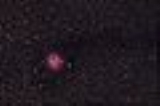
IC 5146
Encyclopedia
IC 5146 is a reflection
/emission
nebula
and Caldwell object
in the constellation Cygnus
. IC 5146 refers specifically to the star cluster and Sh2-125 to the nebula. It shines at magnitude +10.0/+9.3/+7.2. Its celestial coordinates are RA , dec. It is located near the naked-eye star Pi Cygni, the open cluster NGC 7209 in Lacerta
, and the bright open cluster M39
. The cluster is about 4,000 ly away, and the central star that lights it formed about 100,000 years ago; the nebula is about 12 arcmins across, which is equivalent to a span of 15 light years. When viewing IC 5146, dark nebula
Barnard 168 (B168) is an inseparable part of the experience, forming a dark lane that surrounds the cluster and projects westward forming the appearance of a trail behind the Cocoon.
Reflection nebula
In Astronomy, reflection nebulae are clouds of dust which are simply reflecting the light of a nearby star or stars. The energy from the nearby star, or stars, is insufficient to ionize the gas of the nebula to create an emission nebula, but is enough to give sufficient scattering to make the dust...
/emission
Emission nebula
An emission nebula is a cloud of ionized gas emitting light of various colors. The most common source of ionization is high-energy photons emitted from a nearby hot star...
nebula
Nebula
A nebula is an interstellar cloud of dust, hydrogen gas, helium gas and other ionized gases...
and Caldwell object
Caldwell catalogue
The Caldwell Catalogue is an astronomical catalog of 109 bright star clusters, nebulae, and galaxies for observation by amateur astronomers. The list was compiled by Sir Patrick Caldwell-Moore, better known as Patrick Moore, as a complement to the Messier Catalogue.The Messier Catalogue is used...
in the constellation Cygnus
Cygnus (constellation)
Cygnus is a northern constellation lying on the plane of the Milky Way. Its name is the Latinized Hellenic word for swan. One of the most recognizable constellations of the northern summer and autumn, it features a prominent asterism known as the Northern Cross...
. IC 5146 refers specifically to the star cluster and Sh2-125 to the nebula. It shines at magnitude +10.0/+9.3/+7.2. Its celestial coordinates are RA , dec. It is located near the naked-eye star Pi Cygni, the open cluster NGC 7209 in Lacerta
Lacerta
Lacerta is one of the 88 modern constellations defined by the International Astronomical Union. Its name is Latin for lizard. A small, faint constellation, it was created in 1687 by the astronomer Johannes Hevelius. Its brightest stars form a "W" shape similar to that of Cassiopeia, and it is thus...
, and the bright open cluster M39
Messier 39
Open Cluster M39 is an open cluster in the Cygnus constellation. It was discovered by Charles Messier in 1764. M39 is at a distance of about 800 light years away from Earth...
. The cluster is about 4,000 ly away, and the central star that lights it formed about 100,000 years ago; the nebula is about 12 arcmins across, which is equivalent to a span of 15 light years. When viewing IC 5146, dark nebula
Dark nebula
A dark nebula is a type of interstellar cloud that is so dense that it obscures the light from the background emission or reflection nebula or that it blocks out background stars . The extinction of the light is caused by interstellar dust grains located in the coldest, densest parts of larger...
Barnard 168 (B168) is an inseparable part of the experience, forming a dark lane that surrounds the cluster and projects westward forming the appearance of a trail behind the Cocoon.

